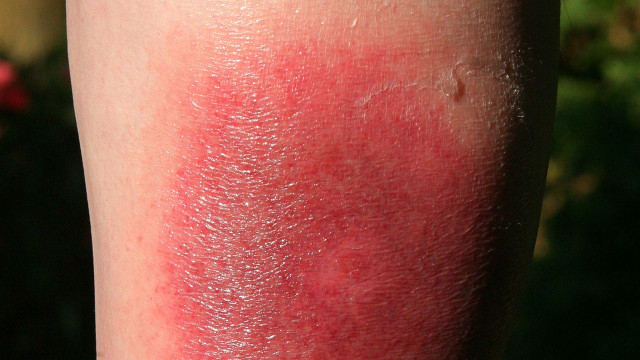
If you are bitten by an infected tick, there is a risk that you will become infected with tick-borne encephalitis (TBE) or Lyme disease bacteria. Here you can find out what the typical symptoms of both diseases are and what to do if you experience symptoms.
The good news first: just because a tick has got on your body does not automatically mean that it will give you a disease. In order to cause an infection, the tick must first carry the bacteria or viruses that cause the disease – and pass them on.
Diseases that can be transmitted by ticks include Lyme disease and tick-borne encephalitis (TBE). Lyme disease is a bacterial infection that, according to the Robert Koch Institute (RKI), can affect various organ systems. TBE is transmitted via viruses – it is an inflammation of the brain or meninges. Lyme disease is more common than TBE.
According to the German Brain Foundation, around three percent of tick bites result in Lyme disease. TBE viruses are mainly found in southern Germany. The RKI publishes a map of the main endemic areas every year. On average, 0.1 percent to 5 percent of ticks in TBE risk areas carry TBE viruses, explains the Robert Koch Institute (RKI).
It is important to know how the diseases manifest themselves – and how to protect yourself from them.
What are the symptoms of early summer meningoencephalitis?
TBE initially manifests itself through fever, headache and aching limbs, i.e. a general feeling of illness. The symptoms are similar to those of the flu and are often misinterpreted. Once the symptoms subside, many people have overcome the illness – but not everyone.
In some infected people, the meninges, brain or spinal cord become inflamed in a second phase of the disease about a week later. This can be accompanied by fever, headaches and nausea. “Sick people are also often sensitive to light,” says Kristina Huber, a doctor in the outpatient clinic of the Department of Infectious Diseases and Tropical Medicine at the LMU Munich Hospital.
In severe cases, seizures, paralysis – for example in the arms and legs – and swallowing and speech disorders are possible. Subsequent damage, such as permanent impairment of fine or gross motor skills, cannot be ruled out. People who have TBE are not contagious.

By the way: Immediately after a tick bite, the affected area often becomes itchy and red – this is normal. It usually disappears within a few days. And if a red, spreading spot appears several days after the tick bite? Then this is a sign of Lyme disease, not TBE. It makes sense to go to the doctor.
According to the Robert Koch Institute, 475 cases of TBE were reported in Germany in 2023. Almost all of those affected were not or only inadequately vaccinated.
Lyme disease: What are the signs?
In addition to TBE, Lyme disease is the second disease that can be transmitted by ticks. Lyme disease can have very different courses. This is because the disease affects different – and often several – organ systems. These can be the skin, nerves, joints or heart, as the German Brain Foundation explains.
The infection can also go unnoticed. However, if it causes symptoms, erythema migrans is typical.
Recognizing typical erythema migrans
This is how you recognize erythema migrans: A circular redness with a diameter of at least five centimeters forms around the bite site. This can happen as early as three days after the tick bite, but it can also only appear after around 30 days. The redness continues to spread and can reach a diameter of up to 20 centimeters.

However, not every case of Lyme disease is accompanied by erythema migrans. According to the German Brain Foundation, this symptom only occurs in three out of four sufferers who show symptoms.
Other signs of Lyme disease include fever, chills and/or fatigue. Muscle and joint pain can also occur in the days or weeks after the bite. If Lyme disease affects the nervous system, nerve irritation, numbness, visual or hearing problems or paralysis can occur.
Important to know: Lyme disease can have a second phase of the disease, which sometimes only begins months after the tick encounter. This can lead to meningitis, which can be noticed, among other things, by paralysis of the face on one or both sides.
I think I’m affected. What now?
Anyone who suspects they have Lyme disease should see their family doctor. The good news is that the disease can be easily controlled with antibiotics, which can also protect against serious complications.
Precisely because it can take so long for Lyme disease to show itself, the German Brain Foundation advises: Keep in mind that you were bitten by a tick – it’s best to note the date.
How can I prevent Lyme disease?
Good to know: It takes several hours for the Borrelia (i.e. the pathogens that cause Lyme disease) to enter the body when a tick bites, explains the German Brain Foundation. “Up to 12 hours after the bite, the probability of Borrelia being transmitted is still very low. So anyone who discovers the tick bite during this period and removes the tick completely does not usually have to worry about Lyme disease.”
It is therefore important to search the body thoroughly immediately after excursions and to remove ticks quickly – for example with a tick card or tick pliers or even tweezers.
Of course, it is best if the tick does not have the opportunity to bite in the first place. Therefore, you should wear long trousers when going out into the countryside – ideally long sleeves too. Anti-tick lotions and sprays can also help keep the animals away. Incidentally, unlike TBE, there is no vaccination against Lyme disease.
Read more on Techzle\.com:
- Ticks extremely active: “There is no longer a winter break”
- Repel insects: These home remedies help against mosquitoes, wasps, etc.
- Tick remedies for dogs: These natural remedies help
** marked with ** or orange underlined Links to sources are partly affiliate links: If you buy here, you are actively supporting Techzle\.com, because we then receive a small part of the sales proceeds. .